This is the fifth in a series of discussion of selected parts of Paul Strathern’s The Other Renaissance: From Copernicus to Shakespeare, (Atlantic Books, 2023). For more general details on both the author and his book see the first post in this series.
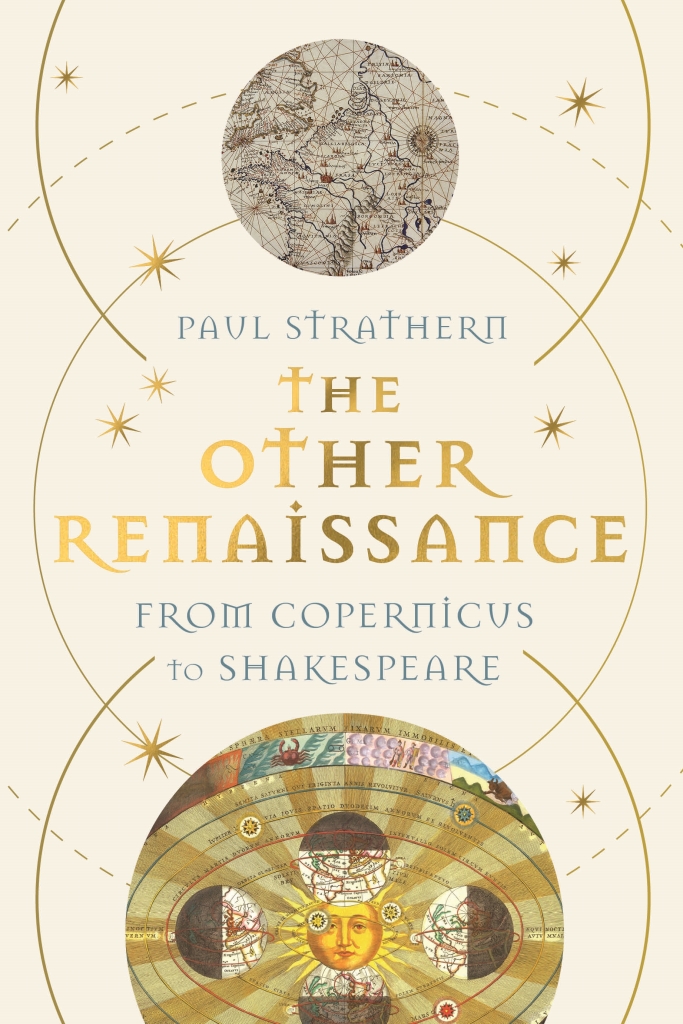
Today, I’m looking at Strathern’s chapter on Vesalius. It goes without saying that Strathern evokes the mythical religious taboo on dissection of the human body.
The dissection of human bodies had been a religious taboo in the western world since well before the birth of Christ. This taboo extended through all Abrahamic religions – i.e. Judaism, Christianity and Islam – as well as most of the heterodox sects and cults which pervaded the Mediterranean region and the rest of Europe.
Whilst there was a prohibition on the dissection of human cadavers from about 150 BCE in Ancient Rome that affected the work of Galen (129–c. 216 CE), who as Strathern reports carried out most of his anatomical work on animals, which of course led to anatomical errors; there was no taboo in the European Middle Ages or the Renaissance, when Leonardo, yes, he gets discussed too, and Vesalius carried out their anatomical studies. Human dissection had already begun in the fourteenth century with the work of Mondino de Luzzi (C. 1270–1326) and by 1400 regular anatomical dissections were an established part of the curriculum in most medical schools. Strathern then delivers up another of his errors on authority:
Despite such mistakes, Galen’s ‘authority’ on medical matters reigned supreme throughout the medieval era, alongside that of Aristotle. Not until the Renaissance would his errors come to light.
Galen was just one of several medical authors whose texts were used on the medieval universities and despite challenges continued to be used throughout the Renaissance. In fact, there was during the Renaissance a strong neo-Galenic movement that challenged Vesalius.
It’s almost unavoidable that Strathern, like everybody else, includes Leonardo, he writes:
A century prior to Vesalius, Leonardo da Vinci’s obsessive curiosity led him to carry out dissections of human cadavers, which he recorded in his notebooks. By now the prohibition of such activities had become somewhat more relaxed, though they remained frowned upon.
As already noted, there was no prohibitions and Leonardo, like all the apprentices of Andrea del Verrochio (1435–1488), who insisted that his apprentices gain a thorough grounding in anatomy, would have attended dissections as an apprentice.
Leonardo carried out systematics anatomical investigations together with Marcantonio della Torre (1481–1511), lecturer on anatomy at the universities of Pavia and Padua, between 1510 and 1511. Vesalius’ principle anatomical work, his De fabrica, of which more later, in 1543. According to my arithmetic that is a span of thirty-one years and not a century. Maybe Strathern uses a different number system?
We get no account of Leonardo’s systematic work with Andrea del Verrochio this would spoil the image that Strathern creates of the chaotic nature of Leonardo’s work and notes. We do, however get a lengthy anecdote about his dissection of a man who claimed to be one hundred years old. Then Strathern drops the following gem:
But why this diversion? What possible relevance does such work by Leonardo have to the northern Renaissance? In fact, none. And that is the point. By recounting these pioneering anatomical experiments – unique in their breadth, depth and explication – we gain an insight into the immense difficulties involved in human dissection during this period. We can also witness the birth of a new, forbidden science coming into being. Or apparently so. For this infant body of learning would not survive its premature birth – stillborn before it could draw breath – largely through the procrastination of Leonardo himself.
As already stated, we do not have “the birth of a new, forbidden science”, dissection of human cadavers was routine by the time that Leonardo was active. Also, if he poses the question, “What possible relevance does such work by Leonardo have to the northern Renaissance?” then he must also pose it for Vesalius, who although he came from the Netherlands did all his anatomical work in Padua and was very much an integral part of the Italian Renaissance.
We then get a brief description of the fate of Leonardo’s papers and drawings which closes with the repeat of the arithmetical error:
Working a century later, Vesalius would remain unaware of Leonardo’s pioneering work, which remained lost to history.
Leonardo lived from 1452 to 1519, Vesalius was born in 1514 and carried out his anatomical work in Padua beginning in 1537, publishing the De fabrica in 1543. No matter how I try I can’t make a century out of these dates! The century is merely a lead into a piece of pseudo historical pathos:
Such a lacuna leads one to speculate on how much more, of genuine worth, was lost during this period. Such discovery and progress had little place in the medieval era. The Renaissance would have to find its own way of accommodating and preserving the innovations it produced. All we know are the successes which eluded loss or destruction: Copernicus’s revolutionary work published by his friends and gifted to him on his deathbed; Paracelsus’s haphazard discoveries, and superstitious lapses, disseminated by means of Gutenberg’s invention, which was itself wrested from the hands of its creator. In this aspect, more than most, no history can be any more than an incomplete account. Fortunately for history, Vesalius would do his utmost to gainsay this fact, his work being both painstaking and thorough from the outset. And his motives throughout his long and arduous task would be single-mindedly focused on public recognition and public reward.
In the history of science many new ideas, theories and discoveries have been lost, forgotten, or suffered a delayed reception. The reasons are numerous but, and it’s a very big but, they were not somehow actively repressed during the Middle Ages as Strathern would have us believe. I have already pointed out in my review of the chapter on Copernicus, his work was not published by his friends in an act of deception as Strathern claims, but he sent his book to Petreius in Nürnberg to be published himself. Paracelsus’ work was mostly posthumously printed and published by his disciples, a case of late reception and in Gutenberg’s case, if you build up your business with large sums of borrowed cash and then get into a dispute with your financier, then you tend to lose your business. However, the invention of printing with moveable type was in no way effected by Gutenberg’s financial problems. Strathern’s examples don’t illustrate his argument at all.
We now arrive at Vesalius and the usual brief biography. Strathern tries to paint his father as somehow inferior and suffering from an inferiority complex. Claiming that it was his mother who raised him and set him on his way entering him, like Mercator and Gemma Frisius before him, in a school of the Brotherhood of the Common life, in his case in Brussels. It was actually his father who entered him in the school. Like Mercator and Gemma Frisius, Vesalius now entered the University of Leuven, and Strathern displays his total ignorance of the medieval university system:
Surprisingly, Vesalius did not register at the school of medicine, but instead chose to study the arts and humanities, which included learning Latin and Greek, at which he thrived. (The books in his grandfather’s library would mostly have been written in Latin, and Vesalius almost certainly had extended his schoolboy Latin by reading these works.) After young Vesalius graduated with a good arts degree in 1532, he was accepted to study at the prestigious University of Paris, where he entered the school of medicine. Only now did he begin the formal study of this subject.
On the medieval university the undergraduate course of study, in the lower faculty, was nominally the seven liberal arts. First when a student had graduated from the lower faculty, was he permitted to matriculate in one of the higher faculties to study, theology, law, or medicine. So, it was not a surprise that “Vesalius did not register at the school of medicine.”
We get some more misinformation from Strathern:
Despite its reputation, the University of Paris remained firmly committed to the teachings of Aristotle, and its school of medicine was still dominated by the 1,300-year-old ideas of Galen. Lectures in practical anatomy were a comparatively rare novelty, having only recently received limited Church dispensation [my emphasis].
Lectures in practical anatomy were a standard part of the medical curriculum in Paris, there being no Church restriction on them as I’ve already explained above. Strathern contradicts himself by explaining that anatomical lectures, with public dissections, were a standard part of the curriculum, although he correctly observes that the student were only allowed to observe but not to dissect themselves. He notes correctly that the one professor of anatomy, Jacobus Sylvius (1478–1555) was a strict adherent of Galen but that another, Johann Winter von Andernach (1505–1574) was more open minded and even allowed students to participate in dissections. Winter became Vesalius’ mentor and even employed Vesalius as an assistant in the preparation of his four volume Institutiones anatomicae (Paris, 1536) for the press, praising him in the preface; it would become a standard work, of which Vesalius published a second updated edition in 1539. It should, however, be pointed out that Winter was one of those who triggered to renaissance in Galenic anatomy when he produced the first Latin translation of Galen’s newly discovered and most important De Anatomicis Administrationibus (On Anatomical Procedures) 9 vols. Paris in 1531, which Strathern doesn’t mention at all.
Strathern delivers up some waffle about what happened next when Vesalius was forced by war to leave Paris and return to the Netherlands, where he re-entered the University of Leuven to complete his medicine degree. Here he wrote his doctoral thesis and Strathern once again displays his ignorance:
At the same time, Vesalius began composing his graduation thesis. Interestingly, he chose for his subject the tenth-century Persian physician and alchemist known in the west as Rhazes. (In the Arabic world his full name was Abu Bakr Muhammad ibn Zakariya al-Razi.) The important fact about Rhazes was that he not only based his science upon the experiments he conducted himself, but he also wrote these out in detail, step by step. This meant that they could be precisely repeated by other scientists. Here, reliance upon the word of a universal and unchanging ‘authority’ was skilfully circumvented.
This important lesson would soon begin to permeate the world of science in both the northern and the Italian Renaissance. The days when scientists – from mathematicians to alchemists – kept their discoveries secret in order to gain advantage over their rivals were coming to an end. Science was entering the public domain. Experimenters would publish their work in books, and their results could be verified (or shown to be faulty) by their peers.
Vesalius’ doctoral thesis was actually Paraphrasis in nonum librum Rhazae medici Arabis clarissimi ad regem Almansorem, de affectuum singularum corporis partium curatione, a commentary on the ninth book of Rhazes.
Strathern tries to make it seem as if Vesalius’ thesis was in somehow exceptional in its choice of topic and in some way ground-breaking, whereas it was perfectly normal. The book of Rhazes referred to here is his The Virtuous Life (al-Hawi), a nine-volume posthumous collection of his medical notebooks, which was translated into Latin in the late thirteenth century and was a standard textbook in the medical faculties of the European medieval universities, so there was nothing exception about Vesalius writing his doctoral thesis on part of it. Strathern continues:
Vesalius’s reputation as a talent of great promise seems to have spread far and wide, almost certainly aided by Andernach’s description of him in Institutiones Anatomicae. Immediately upon his graduation from Leuven, Vesalius received an invitation to become a professor of anatomy and surgery at the University of Padua, one of the finest centres of scientific research in Italy.
This proving that Vesalius was very much part of the Italian Renaissance and not the Northern Renaissance! Now Strathern starts off on a path where he will begin to mix fact with fiction:
More importantly for Vesalius, Padua was just twenty miles from Venice, the commercial and cultural capital of the region, and it was here that he met the German-born artist Jan von Calcar, who had served his apprenticeship under Titian. Calcar’s particular talents were his ability to imitate the works of others and his supreme skill with woodcuts.
In 1538 Vesalius collaborated with Calcar on the production of his first anatomical text, Tabulae Anatomicae Sex (Six Anatomical Charts.) Three of these charts were produced by Calcar, taken from a full-scale skeleton of the human body which Vesalius had put together. The other three made use of charts which Vesalius himself had drawn for lectures to his students.
Although the story is well document, Strathern can’t get the facts right. The Tabulae Anatomicae Sex were originally six large, woodcut, wall posters that Vesalius had created for his lecture theatre. He discovered that students were copying them, so he decided to make a professional printed edition of them. Of the printed edition the first three were entirely his own work but for the second set of three he employed Jan van Calcar. Strathern notes correctly that here Vesalius corrects some of Galen’s anatomical errors but repeats some others.
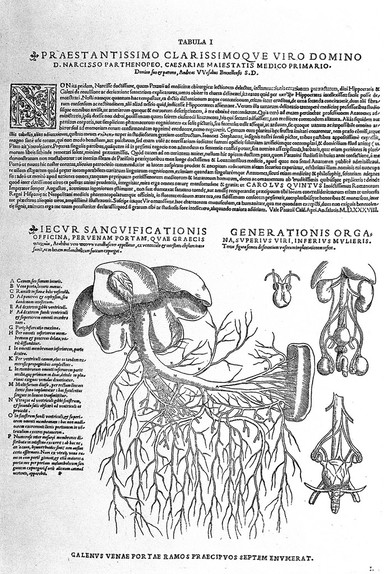
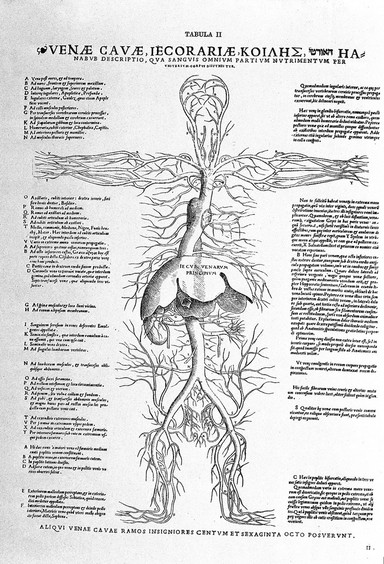
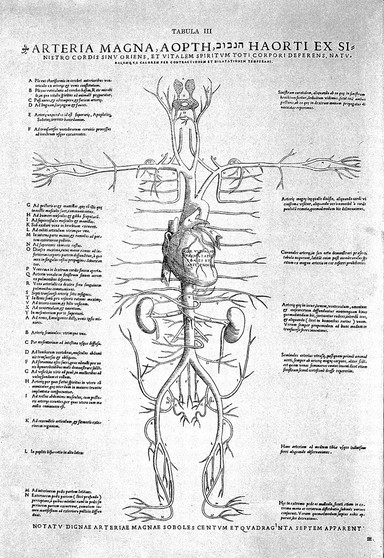
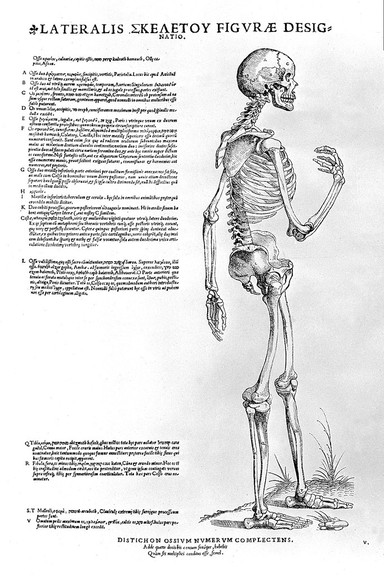
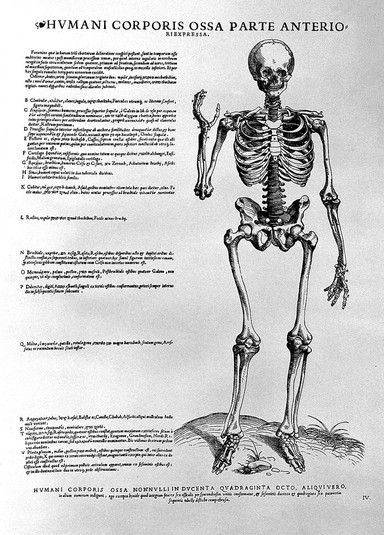
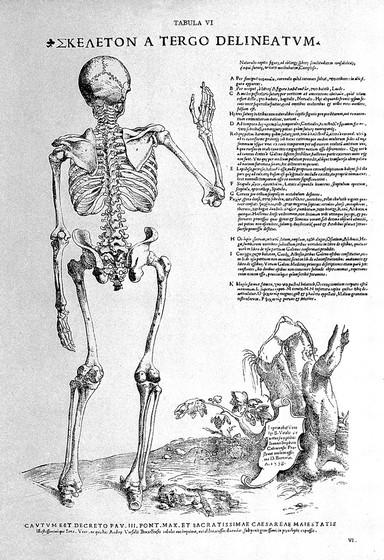
Strathern now delivers up a classic historical myth in a footnote:
From now on, the more Vesalius continued with his investigations of the human body, the bolder he became. By this stage he had reached an agreement with the Paduan authorities, who allowed him to dissect the regular supply of cadavers of prisoners executed on the gallows. Vesalius’s retelling of how he carried out his researches paints a vivid, if lurid, picture. He described how he ‘would keep in my bedroom for several weeks bodies from graves or given me after public executions’. How did his neighbours put up with the appalling stench? To say nothing of their suspicions that he might be indulging in necromancy or demonology? The answer is that they may well have been unable to distinguish the stench from the general pervasive malodorousness.*
* During this era the waterways of Padua, like the canals of Venice and its nearby lagoon, emitted powerful smells, especially in the summer. This was hardly helped by the customary lack of bathing and personal hygiene which pervaded all classes throughout Europe. [my emphasis] Indeed, such habits accounted for the constant use of sweet- smelling nosegays in genteel society. These consisted of flowers or herbs intended to mask the sense of smell. It is said that in Venice a certain type of nosegay evolved which went further, using citrus oil or extracts of resin intended to numb the olfactory sense altogether, rather than simply distracting it.
The sentence that I have emphasised is, unfortunately, a widespread myth and total piffle! Europeans in the Renaissance bathed regularly and took great care of their personal hygiene. Nobody claiming to be an academic historian, as Strathern does, should be repeating this garbage in 2023! On the subject of demonology Strathern drops the following gem:
As for the suspicion that Vesalius might have been involved in occult practices – presumably he remained under the protection and good name of the university. This was still an era when a large majority of the population believed in demonology, witchcraft and the like – general superstition was rife. Here was one area where the power of the Church and its insistence on orthodoxy was beneficial: in its suppression of heretical practices and beliefs, it undoubtedly reduced the credulity [my emphasis] which led to the outbreaks of mass hysteria that were prevalent during this period.
It was the Church with its insistence on the real existence of the Devil, demons, black magic, witches, and all the rest that was the main driving force fuelling the credulity.
It is now that Strathern begins mixing fact with fiction or maybe fantasy.
Vesalius now began assembling, together with Calcar, the large, precisely delineated drawings that would become the body of the master- piece which assured his lasting place in medical history. Apart from Leonardo’s, previous books containing anatomical illustrations had tended to be schematic, or cartoon-like, mostly drawn by their medical author – whose talent would often be amateurish at best. By contrast, Vesalius’s De Humani Corporis Fabrica (The Apparatus of the Human Body) would not only be comprehensive and encyclopedic in its knowledge, but its precise illustrations would also be works of art as much as science. Calcar’s large exact drawings, made under Vesalius’s painstaking direction, would in their own distinctly different style be a match for the as-yet-unseen drawings of Leonardo.* Meanwhile Vesalius’s text would set medicine free from the stranglehold of Galen.
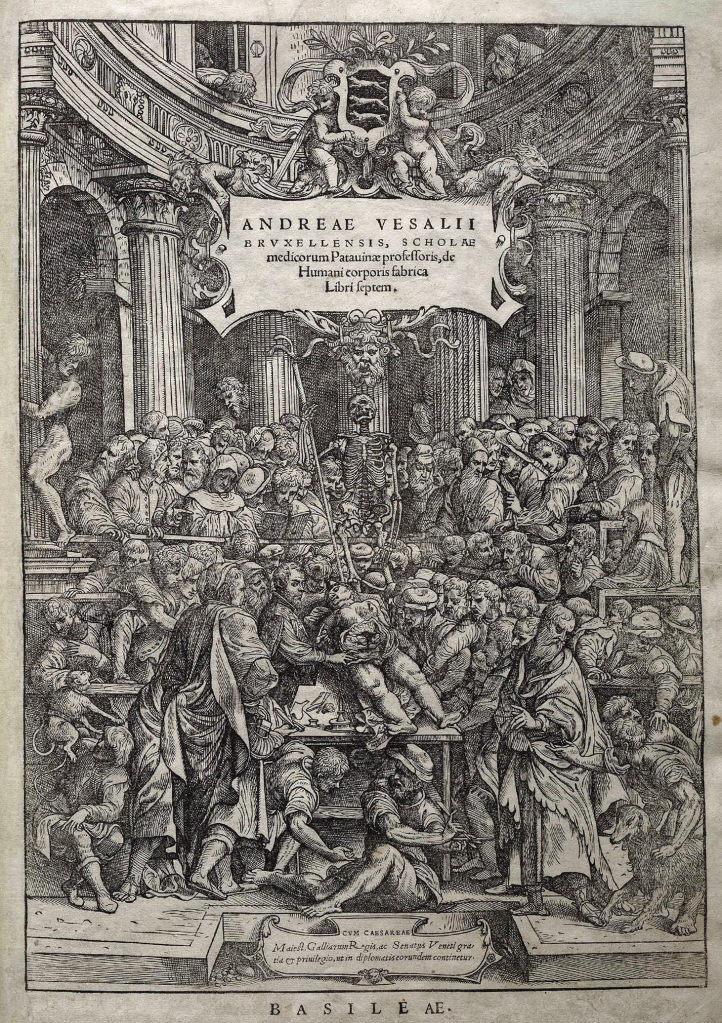
That Calcar was the artist, who created the illustration in De fabrica is an unsubstantiated claim made by Giorgio Vasari (1511–1574) in his Le Vite de’ più eccellenti pittori, scultori, ed architettori (Lives of the Most Excellent Painters, Sculptors, and Architects), 1st edition 1550, 2nd expanded edition 1558, a book not exactly renowned for its historical accuracy. There is no mention in the De fabrica, who the artist actually was. In a footnote in her The Scientific Renaissance 1450–1630 (ppb. Dover, 1994) Marie Boas Hall writes about the illustrations:
These are attributed to Jan Stephen van Calcar (1499–c. 1550) by the sixteenth-century art historian, Vasari. Modern students have doubted this, because the figures are as superior to those of the Tabulae Sex as the text of the Fabrica is to that of the earlier work–though it is possible that the artist had learned as rapidly as the author. In place of Jan Stephen van Calcar, the only candidate is an unknown, also a member of Titian’s studio. It seems difficult to believe that so spirited a draughtsman as the artist who drew the pictures for the Fabrica should be otherwise unknown; though it is odd that Vesalius, who had given Jan Stephen credit for his work on the Tabulae Sex, did not mention the name of the artist of the Fabrica.
It has also been speculated that is unlikely that a single artist created all 273 illustrations in such a short period of time. So, Jan van Calcar as the author of the medical illustrations in De fabrica is anything but an established fact but this doesn’t stop Strathern writing the following in a footnote to the paragraph quoted above:
* Such artistry did not come cheap. Indeed, Vesalius was unable to pay Calcar, and in lieu of a fee he signed over to the artist any future profits the Fabrica would make.
Either Strathern is making things up or he is quoting a source, which he doesn’t name, that is making things up without checking on the accuracy of the claim made. It doesn’t stop here. Later in his lengthy description of the book itself he writes:
Alas, Vesalius’s perfectionism would result in an increasing number of quarrels with Calcar. Breaks in their collaboration now followed, and Vesalius began drawing a number of the anatomical illustrations in the Fabrica himself.
A couple of paragraphs further on:
By now, it appears, Calcar had quit the project altogether. We must imagine him storming off in some indignation at Vesalius’s tenacious insistence upon the minutest detail. (This was woodcut, remember, not drawing; erasure was no simple matter with a gouged wooden surface.)
Here also Strathern appears to not know the difference between the artist and the woodblock cutter. Calcar or whoever was the artist, would draw the images onto the surface of the woodblock, but the actual cutting would be done by a professional woodblock cutter and not the artist.
I’m not going to do a blow-by-blow analysis of Strathern’s long account of De fabrica, as this review is already over long, but just mention a couple of salient points. To start with Strathern makes no mention of the fact that just as Copernicus modelled De revolutionibus on the Epytoma…in Almagestum Ptolomei of Peuerbach and Regiomontanus, so Vesalius modelled his De fabrica on Galen’s De Anatomicis Administrationibus (On Anatomical Procedures), which as I mentioned above was first translated into Latin and published by his mentor Johann Winter von Andernach.
At one point Strathern tells us, “As the work continues, the illustrations become less precise and their interpretation less exact.” The final chapter of De fabrica, Book VII, deals with the brain and Strathern writes, apparently contradicting himself, “Ensuing books of the Fabrica would prove similarly perceptive – especially Vesalius’s investigations of the human brain.” Do these images appear imprecise to you?
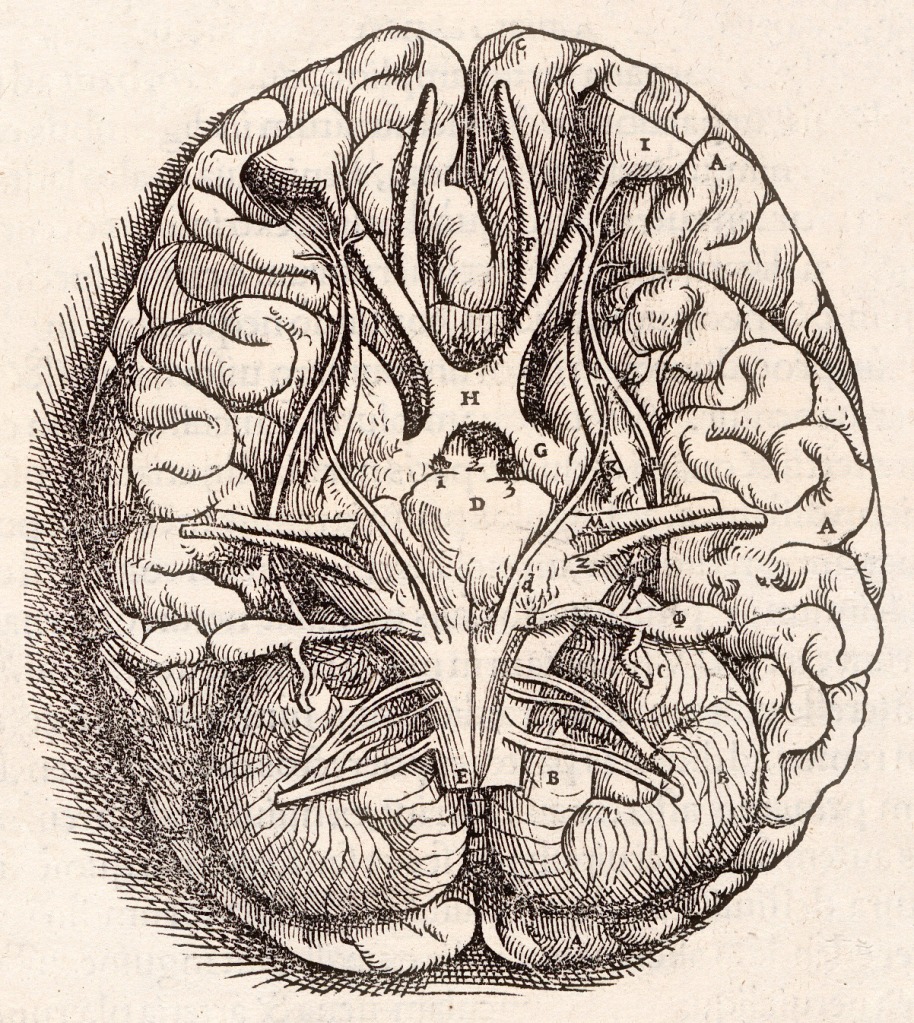

Strathern also writes, And the illustration of the pregnant uterus containing a foetus is undeniably medieval in its crudity…” I really have to ask, does this look medieval or crude to you?
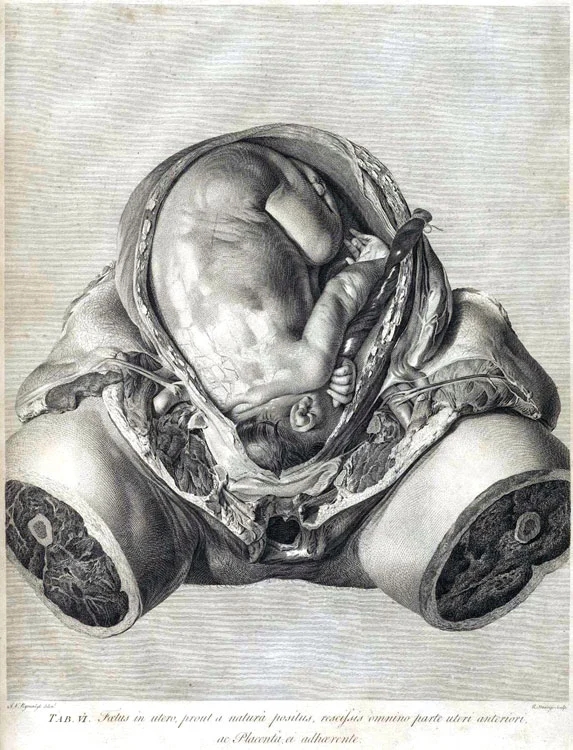
Maybe he was confusing it with the illustration of the placenta with its attached foetus?
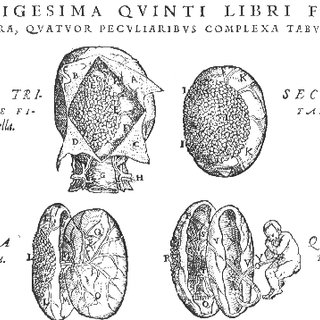
Having completed his tour of De fabrica, Strathern now jumps the shark!
When he had completed the manuscript of Fabrica, he sent the text and illustrations north to Basel in Switzerland. This was the home of Johannes Oporinus, who sixteen years previously had worked as Paracelsus’s long-suffering assistant. Oporinus had now succeeded Paracelsus as a rather more orthodox professor of medicine in Basel. He also happened to come from a family renowned for their printing and engraving skills, and combined his medical knowledge with an expert understanding of the entire printing process. This was the only man in Europe whom Vesalius could trust with the production of his masterwork.
Johannes Oporinus (1507–1568) had very little to do with Paracelsus, he was merely for a brief period in 1527 his famulus. The son of a painter he studied law and Hebrew at Basel University, whilst working as a proofer in the print workshop of Johann Froben (c. 1460–1527). He also worked as a schoolteacher for Latin. From 1538 to 1542, he was professor for Greek at the University of Basel, resigning to devote himself fulltime to his own print workshop.
 100vw, 796px”></a><figcaption class=) Portrait of Johannes Oporinus by Hans Bock Source: Wikimedia Commons
Portrait of Johannes Oporinus by Hans Bock Source: Wikimedia CommonsStrathern closes his chapter on Vesalius with a long-winded account of further biography as Imperial physician to Charles V and later Philip II. Strathern of course cannot resist including the unsubstantiated anecdote that in Spain Vesalius started to carry out an autopsy on a corpse only to discover that the man wasn’t actually dead. There are numerous cases of this happening throughout history, and it even still occasionally occurs today, but whether it actually happened to Vesalius is, as I said, unsubstantiated.
In his chapter on Vesalius, as usual Strathern delivers up a collection of inaccuracies, myths, and in the case of the relationship between Vesalius and Calcar some pure fantasy. Once more I am forced to ask how did this book ever get published?